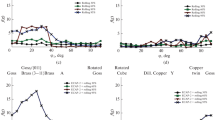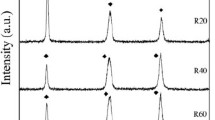Abstract
The stages of structure formation during cold rolling are investigated in bcc (110)[001] single crystals of Fe–3% Si alloy, within the deformation zone. To obtain a visible deformation zone, the laboratory mill is abruptly stopped at the instant of sample rolling. To reduce the frictional coefficient, lubricant is used for some of the samples. The deformational structure is studied by metallography and orientational electron microscopy (EBSD). Deform-3D software is used to analyze the relation between the experimental data and the calculated stress state in rolling, for various values of the frictional coefficient. Depending on the frictional coefficient, the stress state may significantly affect the mesostructure formation and the texture development. In a single crystal rolled with elevated friction, when the deformation is relatively small, deformation bands are formed. Orientational analysis of the contact point of deformation bands reveals alternating microbands, each with slight different orientation, which are separated by small-angle boundaries. In the rolling of a (110)[001] single crystal with lubrication (reduced friction), twinning is observed even with slight deformation. The twinning is evidently due to the reduced contribution of surface energy to the total energy of twin nucleation. Throughout the whole deformation process, either the twins of both systems retain the strict Σ3 crystallographic relation with the matrix or else, on account of the local lattice reorientation, Σ3 disorientations are converted to similar special Σ17b and Σ43c disorientations. On the basis of experimental data, a dislocation model is proposed for the formation of deformational mesostructures in the cold rolling of a (110)[001] single crystal. This model includes the formation of microbands in the initial stage of deformationband generation; the formation of transition bands parallel to the rolling plane with the dynamic retention of the initial orientation; and the formation of transition bands inclined to the rolling plane with a habitus parallel to the {112} matrix plane. These inclined planes are equivalent to shear bands whose habitus is inclined at ~17° to the rolling plane.
Similar content being viewed by others
References
Vishnyakov, Ya.D. and Babareko, A.A., Teoriya obrazovaniya tekstur v metallakh i splavakh (Theory of Texture Formation in Metals and Alloys), Moscow: Nauka, 1979.
Humphreys, F.J. and Hatherly, M., Recrystallization and Related Annealing Phenomena, Amsterdam: Elsevier, 2004.
Furubayashi, E., Behavior of dislocation in Fe–3% Si under stress, J. Phys. Soc. Jpn., 1969, vol. 27, no. 1, pp. 130–146.
Goncharov, V.A. and Karpov, M.I., Plastic deformation of (00-1) [–110] and (110) [–110] molybdenum single crystals by rolling at 293 K. Part 1. Crystallography of sliding, Fiz. Met. Metalloved., 1976, vol. 42, no. 6, pp. 1305–1310.
Goncharov, V.A., Karpov, M.I., and Kopetskii, Ch.V., Plastic deformation of (00-1) [–110] and (110) [–110] molybdenum single crystals by rolling at 293 K. Part 2. Dislocation structure, Fiz. Met. Metalloved., 1977, vol. 43, no. 6, pp. 173–179.
Perlovich, Yu.A., Isaenkova, M.G., and Fesenko, V.A., Regularities of substructural inhomogeneity of deformed metals, Bull. Russ. Acad. Sci.: Phys., 2004, vol. 68, no. 10, pp. 1636–1646.
Lobanov, M.L., Danilov, S.V., Pastukhov, V.I., Averin, S.A., Khrunyk, Y.Y., and Popov, A.A., The crystallographic relationship of molybdenum textures after hot rolling and recrystallization, Mater. Des., 2016, vol. 109, pp. 251–255.
Ushioda, K. and Hutchinson, W.B., Role of shear bands in annealing texture formation in 3% Si–Fe (111)[11] single crystals, ISIJ Int., 1989, vol. 29, pp. 862–867.
Hutchinson, B., Deformation substructures and recrystallization, Mater. Sci. Forum, 2007, vols. 558–559, pp. 13–22.
Dorner, D., Zaefferer, S., and Raabe, D., Retention of the Goss orientation between microbands during cold rolling of an Fe–3%Si single crystal, Acta Mater., 2007, vol. 55, no. 7, pp. 2519–2530.
Dorner, D., Adachi, Y., Tsuzaki, K., and Zaefferer, S., Tracing the Goss orientation during deformation and annealing of an FeSi single crystal, Mater. Sci. Forum, 2007, vol. 550, pp. 485–490.
Rusakov, G.M., Lobanov, M.L., Redikul’tsev, A.A., Karabanalov, M.S., and Lobanova, L.V., Special misorientations in localized deformation regions in Fe–3% Si alloy single crystals, Tech. Phys., 2014, vol. 59, no. 8, pp. 1180–1184.
Xiuhua, G., Kemin, Q., and Chunlin, Q., Magnetic properties of grain oriented ultra-thin silicon steel sheets processed by conventional rolling and cross shear rolling, Mater. Sci. Eng. A, 2006, vol. 430, no. 1, pp. 138–141.
Heo, N.H., Soh, J.Y., Oh, J.M., and Kim, S.B., Influence of cold-rolling texture and heating rate on {110}〈001〉 development in inhibitor-free 3%Si–Fe sheets, J. Magn. Magn. Mater., 2008, vol. 320, no. 20, pp. 635–637.
Lobanov, M.L., Redikul’tsev, A.A., Rusakov, G.M., Kagan, I.V., and Pervushina, O.V., Effect of the grain orientation in the material used for the preparation of an ultrathin electrical steel on its texture and magnetic properties, Phys. Met. Metallogr., 2011, vol. 111, no. 5, pp. 479–486.
Lobanov, M.L., Rusakov, G.M., and Redikul’tsev, A.A., Effect of copper content, initial structure, and scheme of treatment on magnetic properties of ultra-thin grain oriented electrical steel, Phys. Met. Metallogr., 2013, vol. 114, no. 7, pp. 559–565.
Sokolov, B.K., Sbitnev, A.K., Gubernatorov, V.V., Gervasyeva, I.V., and Vladimirov, L.R., On the influence of the annealing heating rate on the recrystallization texture of a deformed single crystal (110) [001] of 3% silicon iron, Textures Microstruct., 1995, vols. 26–27, pp. 427–443.
Tret’yakov, A.V. and Zyuzin, V.I., Mekhanicheskie svoistva metallov i splavov pri obrabotke davleniem (Mechanical Properties of Metals and Alloys under Pressure), Moscow: Metallurgiya, 1973.
Grudev, A.P., Vneshnee trenie pri prokatke (External Friction at Rolling), Moscow: Metallurgiya, 1973.
Rusakov, G.M., Lobanov, M.L., Redikultsev, A.A., and Kagan, I.V., Retention of the twinning S3 misorientation in the process of lattice transformation during cold rolling of a Fe3 Pct Si single crystal, Metall. Mater. Trans. A, 2011, vol. 42, no. 6, pp. 1435–1438.
Author information
Authors and Affiliations
Corresponding author
Additional information
Original Russian Text © A.A. Redikul’tsev, A.G. Uritskii, M.P. Puzanov, A.S. Belyaevskikh, 2017, published in Izvestiya Vysshikh Uchebnykh Zavedenii, Chernaya Metallurgiya, 2017, No. 3, pp. 207–215.
About this article
Cite this article
Redikul’tsev, A.A., Uritskii, A.G., Puzanov, M.P. et al. Formation of internal structure in the rolling of a bcc (110)[001] single crystal. Steel Transl. 47, 165–171 (2017). https://doi.org/10.3103/S0967091217030111
Received:
Published:
Issue Date:
DOI: https://doi.org/10.3103/S0967091217030111




